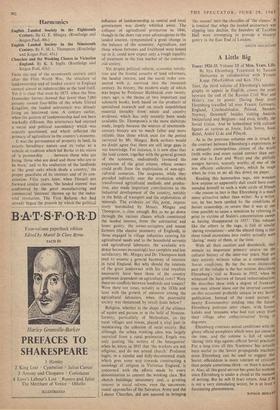A Little Big
Truce: 1921-33. Volume III of Men, Years, Life. By Ilya Ehrenburg. Translated by Tatania Shebunina in collaboration with Yvonne Kapp. (MacGibbon and Kee, 35s.) THIS, the third volume of Ehrenburg's autobio- graphy to appear in English, covers the years
between the end of the Russian Civil War and Hitler's rise to power. During these years Ehrenburg travelled 'all over France, Germany, England, Czechoslovakia, Poland, Sweden, Norway, Denmark' besides visiting Austria, Switzerland and Belgium—and even, briefly, the Soviet Union. And he hobnobbed with cultural figures as various as Joyce, halo Svevo, Isaac Babel, Andre G:de and Pilnyak.
As in the previous volumes one is struck by the contrast between Ehrenburg's experiences as a uniquely cosmopolitan citizen of the world (with wider and more varied contact than any- one else in East and West) and the pitifully meagre harvest, scarcely worthy of one of the less efficient collective farms, which he reaps when he tries to set all this down on paper.
Reading this humourless saga, one wonders how anyone so apparently dull could have com- mended himself to such a wide circle of friends —the reason in fact is that Ehrenburg is a much more attractive talker than writer. As a writer, too, he has been spoiled by the conditions of Soviet censorship, so severe that it was at one time possible to cause a sensation by referring in print to victims of Stalin's concentration camps as having 'disappeared in 1937.' This volume, like the others in the saga, is full of similar 'daring revelations'—and the absurd thing is that these timid excursions into reality actually were 'daring,' many of them, at the time.
With all their 'caution and doubletalk, they remain an important primary source on the cultural history of the inter-war years. Nor are they entirely without value as a comment on Soviet conditions. By far the most interesting part of the volume is the last section. describing Ehrenburg's 'visit to Russia in 1932, when he witnessed the horrors of forced industrialisation' He describes these with a degree of frankness (one may almost leave out the inverted commas on this occasion) probably unique in any Soviet publication. Instead of the usual picture of hearty Komsomoltsy striding into the future. Ehrenburg portrays utter chaos, with former kulaks and 'peasants who had run away froel their village after collectivisation' living in dug-outs.
Ehrenburg contrasts actual conditions with the glossy official pamphlets which were put about at the time, and the volume is full of similar 'daring' little digs against official Soviet practices' For a long time all this 'frankness' has actuallY been useful to the Soviet propaganda machine, since Ehrenburg can be used to suggest that Soviet officialdom is more tolerant of criticism than people sometimes think—or than it actuallY is. Alas• all this good service has gone for nothing. since Ehrenburg is under a cloud at the moment of writing. But he will (I fear) return. And if he is not a very stimulating writer, he is at least g fascinating phenomenon.
RONALD HINOLE1






























 Previous page
Previous page